7 Actionable Email Copywriting Examples to Learn From
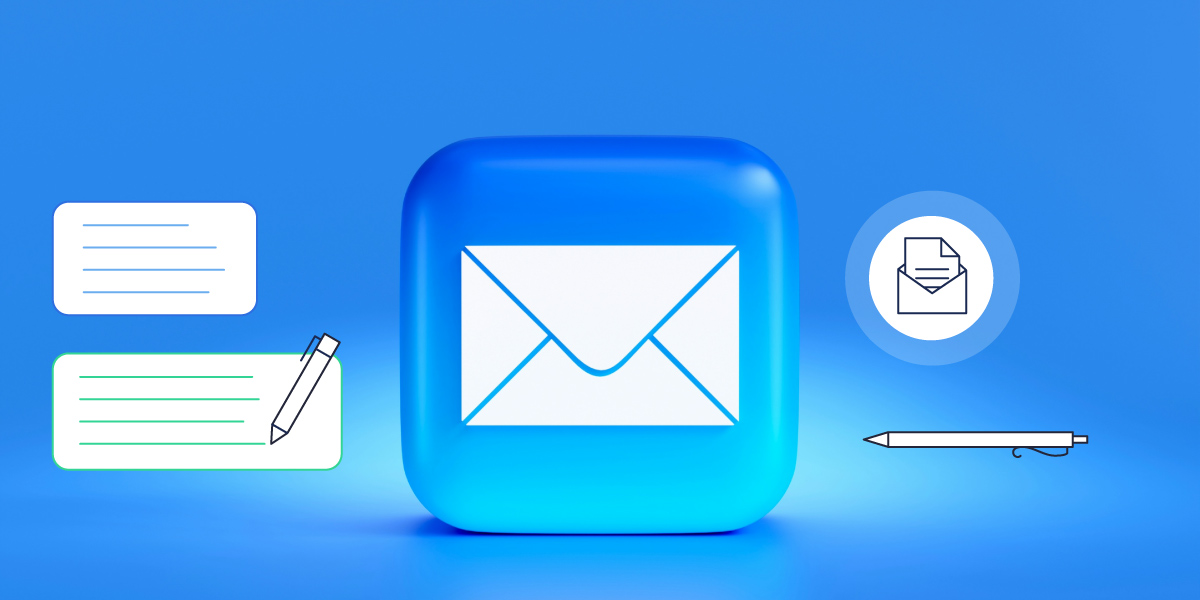
Writer’s block—it gets you every time, doesn’t it? We’ve all been there, staring at that pesky blinking cursor, uncertain how to start the next email. And sure, for inspiration we could show you flashy marketing copy from big-budget brands, but that doesn’t really help when you’re writing for your own business.
Instead, we’re breaking down seven email copywriting examples and tactics, each with clear and actionable takeaways. We’re dishing out smart techniques you can actually use to make your marketing emails more engaging, persuasive, and effective.
How These Email Copywriting Examples Will Make You a Better Writer
Indeed, looking at random email copywriting examples can be helpful—but it doesn’t really create a good foundation for email copywriting. What you need are practical examples that show how great email copywriting works, and not just what it looks like.
That’s why every email copywriting example in this article was crafted to teach you something very specific and replicable. These aren’t cherry-picked from famous brands with million-dollar teams. They’re clear, simple, and built around proven copywriting techniques, so you can learn them, practice them, and use them in your own marketing emails right away.
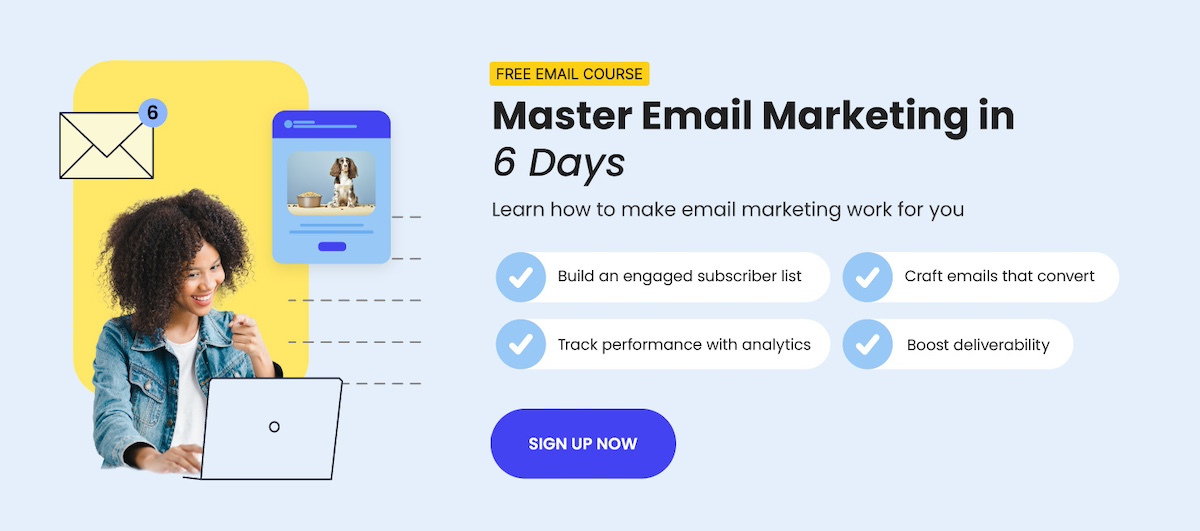
7 Email Copywriting Examples and Why They Work
1. Curiosity + Specificity
When your goal is to get someone to open and read your email, few techniques work as consistently as combining curiosity with a specific, attention-grabbing detail. The curiosity makes the reader want to know more; the specificity gives your message credibility and focus.
Here’s a great example of how that might look in an email:
Subject line: We deleted one line of email text — here’s what happened
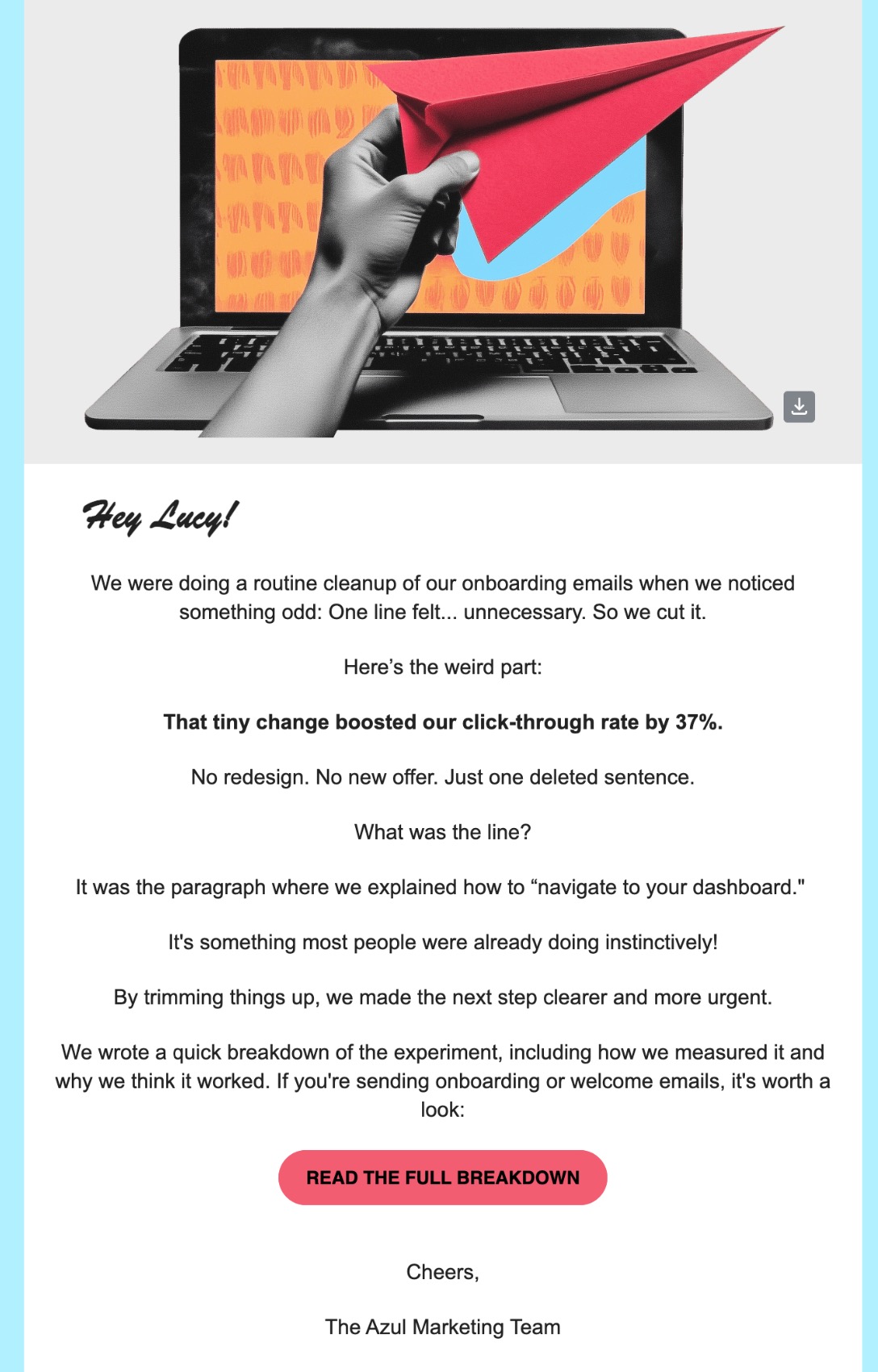
Why it works:
The email subject line plants a question (“what happened?”) with just enough context to feed curiosity—and the body copy delivers a satisfying but concise story. Specificity (a 37% boost) gives credibility, while the tone stays casual and relatable.
The technique:
- Curiosity + specificity
- Bonus: Story-driven setup (a before/after moment with stakes)
When to use it:
This approach works well in email newsletters, product updates, or any content-driven email where you’re sharing an insight, test, or lesson learned. It draws readers in by promising something useful, and all without gimmicky overselling.
2. Problem–Agitate–Solve (PAS)
The PAS formula is one of the most effective copywriting techniques for email because it mirrors how people instinctively think through their own problems. You identify a pain point, dig into the frustration it causes, and then offer relief—ta-da: your solution.
Here’s what this can look like in a real email:
Subject line: Still juggling too many tabs?
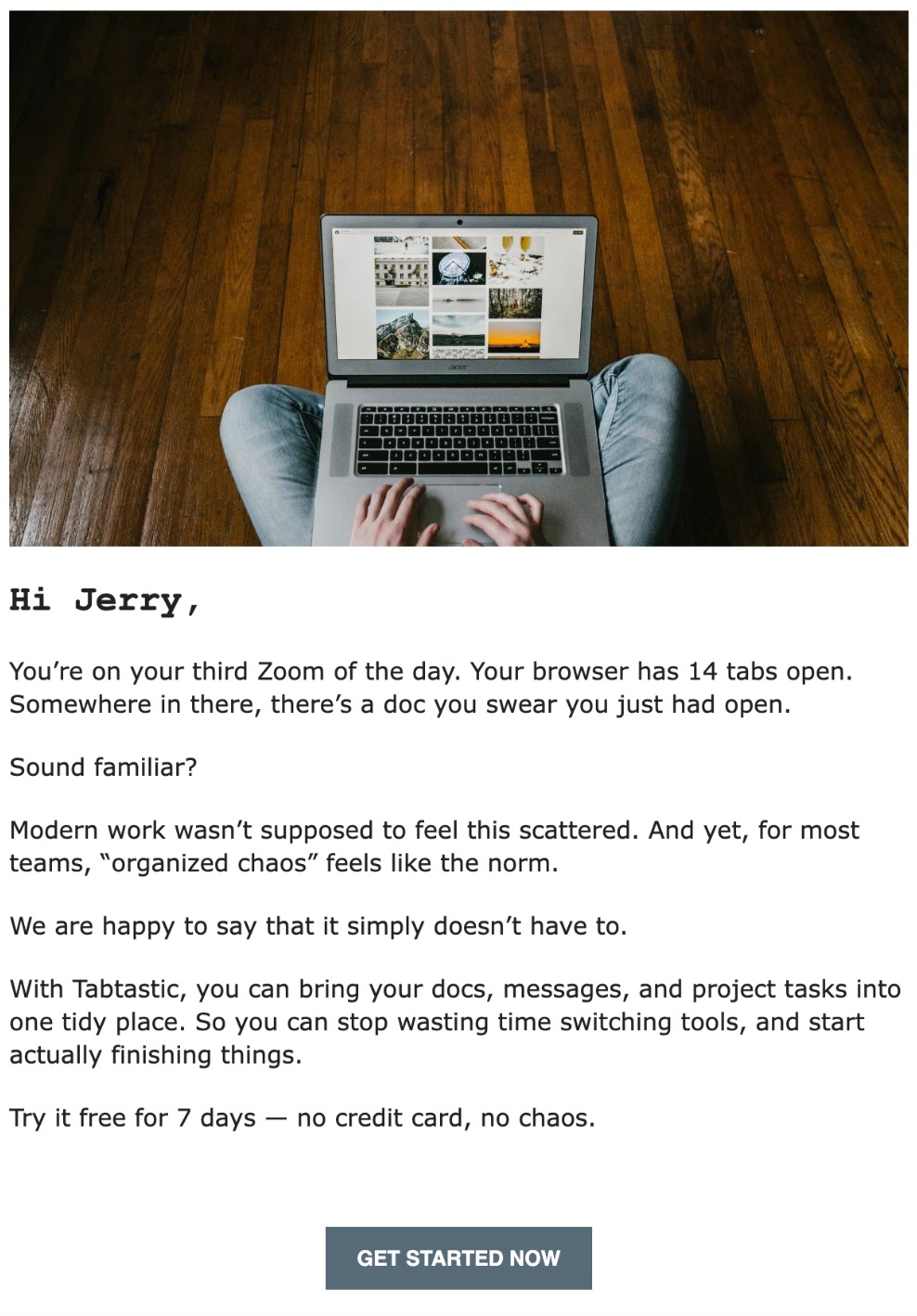
Why it works:
This email follows the classic Problem>Agitate>Solve structure. It opens with a familiar frustration (tab overload, sigh, we’ve all been there), leans into the emotional annoyance of disorganization, and then presents a simple, clear solution with a soft call to action (CTA).
The technique:
- Problem: Scattered work and too many open tabs
- Agitate: Emphasizes emotional impact and familiarity
- Solve: Offers a streamlined, trial-friendly solution
When to use it:
Use PAS when you’re introducing a solution to a specific pain point—whether it’s in a cold outreach, an onboarding sequence, or promotional emails. It’s especially effective when you’re launching tools, services, or features designed to make life easier.
Ready to hit send faster? SiteGround Email Marketing makes it easy with a built-in AI email writer that helps you craft compelling copy in seconds. Plus, you get beautiful templates, contact list management, email campaign automation, and performance tracking—all in one simple, streamlined platform.
3. Micro-Storytelling
Tiny moments tell powerful stories. Micro-storytelling works because it shows (not tells) how a product fits into real life, and makes your reader feel something fast.
Here’s an example from a specialty coffee brand:
Subject line: She called it “the first grounded moment of my day.”
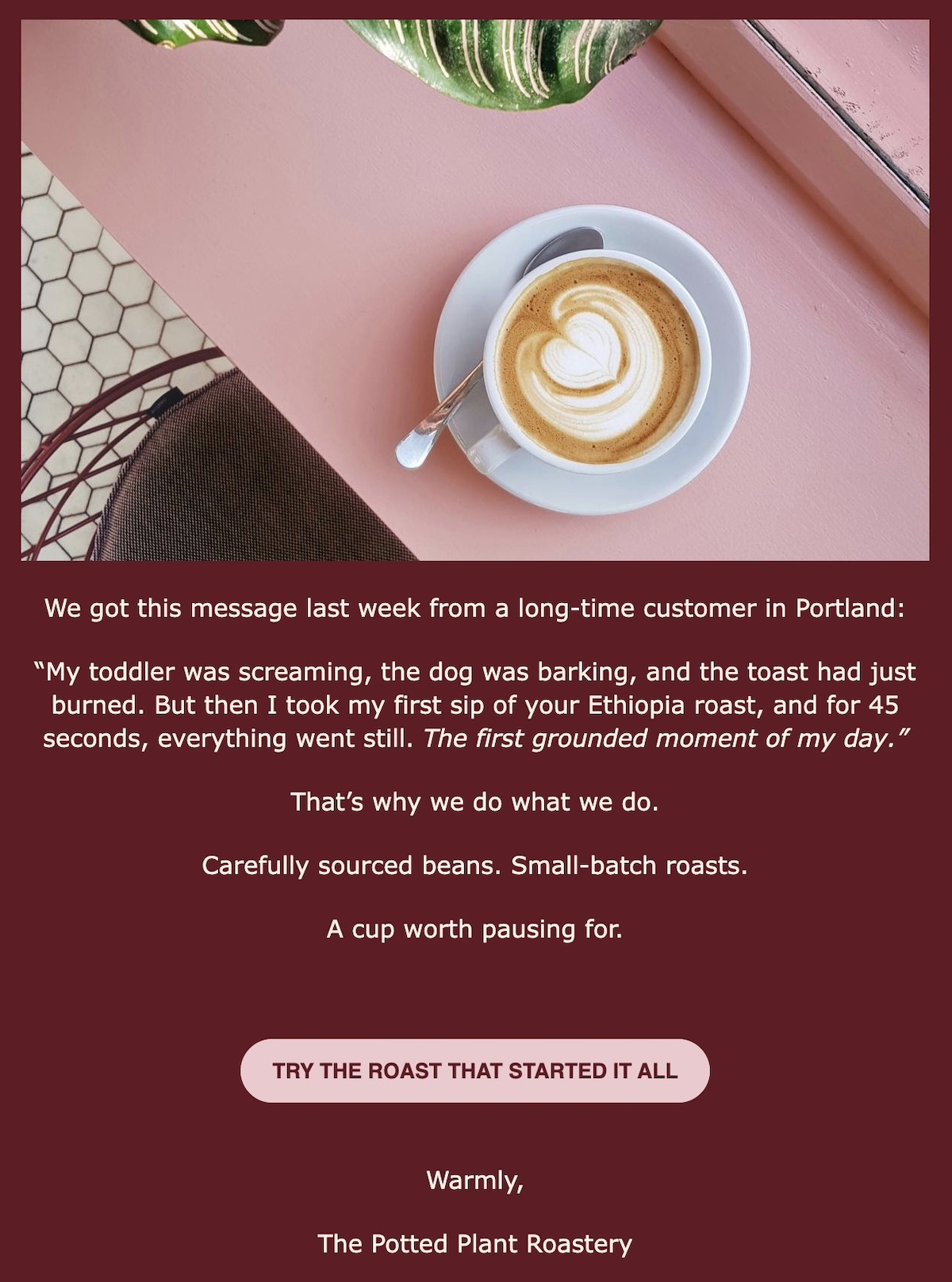
Why it works:
The compelling story is ultra-short and highly relatable—it feels honest, specific, and emotionally grounded. It anchors the product in a feeling (peace in the chaos) instead of just a feature (flavor or origin).
The technique:
- Uses a real quote as the hook to grab the reader’s attention
- The personal story evokes a sensory experience and emotion
- Ties the brand into a familiar, everyday moment
- Soft-sells the product by focusing on why it matters
When to use it:
Ideal for marketing messages ranging from brand storytelling to welcome emails, and highlighting customer love. Great for any product that’s part of a daily ritual, like coffee, tea, skincare, home goods, or wellness.
4. Cliffhanger CTA
A cliffhanger CTA leaves your reader wanting just a little more—which is exactly why they click. This technique teases curiosity or holds back a key detail so the reader has to follow through to find out.
Check out this email copywriting example from a skincare brand:
Subject line: You’ll never guess what’s *not* in this moisturizer
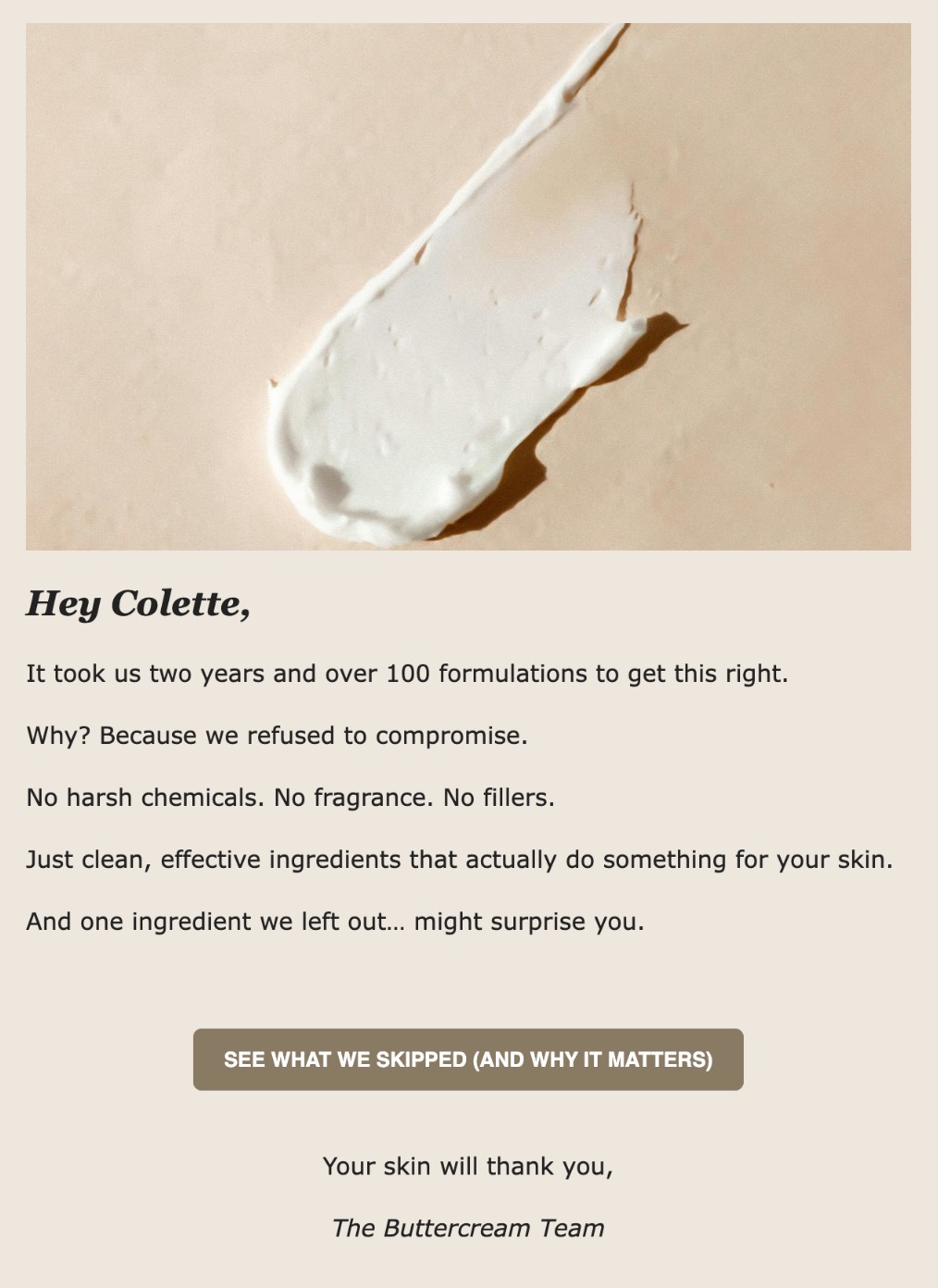
Why it works:
This is a great example because the CTA builds suspense by hinting that something unexpected is missing—and that it’s worth finding out. This taps into your reader’s curiosity, making the click feel irresistible. The rest of the email supports it with authenticity and a clear benefit.
The technique:
- Starts with a bold subject line that poses a question
- Creates a mini origin story (2 years, 100+ versions) in the body copy
- Teases an unexpected insight or twist
- Leaves the “surprise” just out of reach—accessible only by clicking
When to use it:
Best for product launch emails, or educational content that flips expectations. This tactic works well in industries like beauty, wellness, fashion, food, and personal development—anywhere you want to reframe what people think they know.
5. Benefit Stacking
Stacking benefits helps you quickly communicate the full value of your offer by layering multiple clear advantages. This makes it easier for your reader to say “yes” because they see how the product fits their needs in many ways.
Here’s an copywriting example from a meal kit delivery service:
Subject line: Healthy dinners, zero grocery trips, and less cleanup? Yes, please.

Why it works:
This email highlights multiple benefits that appeal to convenience, health, sustainability, and cooking confidence. The stacked list creates a compelling, multi-faceted value proposition.
The technique:
- Benefit stacking in bullets
- Appeals to practical and emotional motivators
- Clear, low-friction CTA
When to use it:
This type of email is great for any product or service with multiple advantages, such as food delivery, subscription boxes, wellness programs, or educational courses.
6. Conversational Tone
A conversational tone helps your emails feel more like a note from a friend than a hard sell. It builds trust, makes your brand feel more human, and encourages engagement—especially in inboxes full of formal marketing speak.
Below is an email copywriting example that demonstrates how that can sound when coming from a pet grooming service:
Subject line: Your dog called. He wants a spa day. 🐾
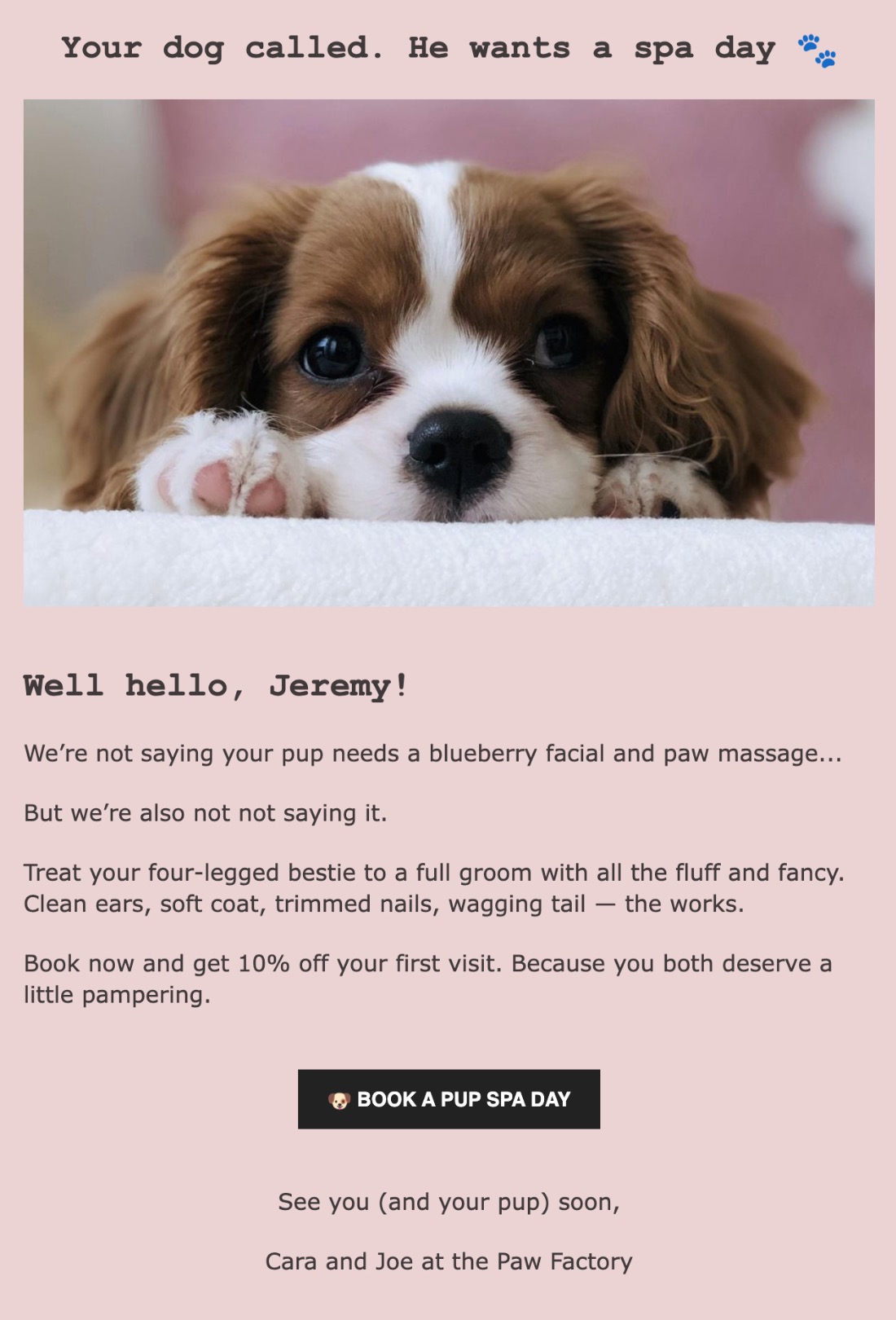
Why it works:
This email feels playful, friendly, and natural—like something you’d forward to a friend. It’s persuasive without sounding like a pitch, and it uses light humor and warmth to connect emotionally.
The technique:
- Informal phrasing (“we’re not saying…”)
- Humor and brand voice consistent with pet-lover culture
- CTA that fits the tone of the message
When to use it:
Ideal for brands with strong personality or loyal customer communities—like pet services, indie ecommerce, personal coaching, or creative products. Especially effective when you want to stand out with tone rather than hard selling.
7. Ethical Scarcity
Scarcity is a classic persuasion tactic, but when done ethically, it builds urgency without relying on gimmicks. It works best when the limitation is real—whether it’s about time, availability, or capacity—and when it’s framed in a respectful, transparent way.
Here’s an example from an online course platform:
Subject line: Enrollment closes Friday—next session won’t open until October
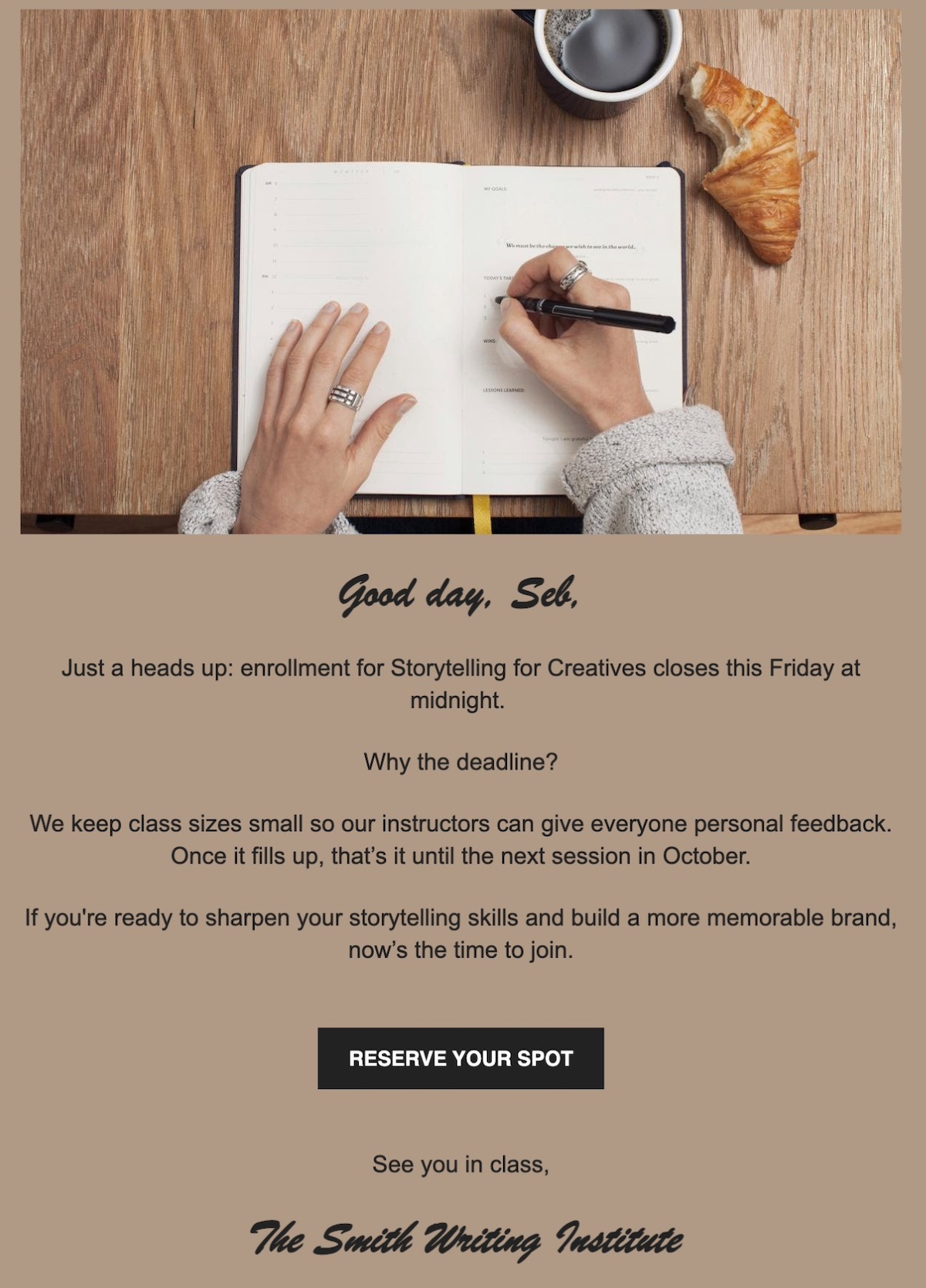
Why it works:
It uses real scarcity (limited class size, set enrollment window), explains why the limit exists (personal attention), and avoids pressure or fake urgency. The tone is respectful and informative.
The technique:
- Time-based scarcity + capacity limit
- Transparent reasoning behind urgency
- CTA with a clear next step
When to use it:
Perfect for courses, coaching, product drops, or seasonal offers (especially Black Friday emails), when timing and availability are real and meaningful.
The Bigger Strategy Behind These Email Copywriting Examples
Great marketing copy doesn’t exist in a vacuum (we looked and just found a bunch of boring dust). Each of the examples above works because it’s part of a broader, intentional email marketing strategy. This is so important!
No matter how clever your subject line or engaging your tone, if the email isn’t thought of as part of a full reader experience, it just won’t perform as well. So here are three essential elements that help these examples succeed—and that you should keep in mind when writing and planning your own email campaigns.
1. Mobile-Optimized Copy
More than half of all emails are opened on mobile devices. That means your email copywriting should be skimmable, scrollable, and fast to load. Keep paragraphs short, use strong headers or bolded phrases, and make CTAs easy to tap. Every copywriting example above was written with a clean structure that would read well on a small screen.
Not sure how to make sure it all looks good on mobile? Lean on an email marketing platform, that makes mobile optimization instantaneous. Copy and images are automatically resized for mobile, and easily previewed right from the email editor.
2. Personalized and Targeted
These emails aren’t meant for everyone; they’re meant for the right someone. Whether it’s using a name, referencing behavior (like a recent event participation), or customizing content to specific needs, personalization helps copy land better. Even if the copywriting examples above didn’t use first names, they spoke directly to a clear, specific target audience.
3. Designed to Support the Customer Journey
Email copywriting isn’t just about generating one-time clicks, but rather about moving people through an email customer journey. That is, some of these examples are perfect for lead nurturing, others for sales conversion, and others still for post-purchase engagement. When your copy aligns with where your reader is in their journey, the email copywriting naturally becomes more effective.
Wrapping Up: The Power of Great Email Copy
Email copywriting isn’t about clever words. It’s about crafting the right words at the right time and for the right target audience. These best copywriting examples above show how these different techniques accomplish that, so that your emails are not only well written, but truly get the job done. Ultimately, when you combine those tactics with a clear strategy, the results speak for themselves.
Ready to put it all into action? With SiteGround Email Marketing, you can easily craft, send, and track beautifully written emails, and all from the same platform where you host, manage, and create your site. It’s built for small businesses who want simple, powerful tools that grow with them.
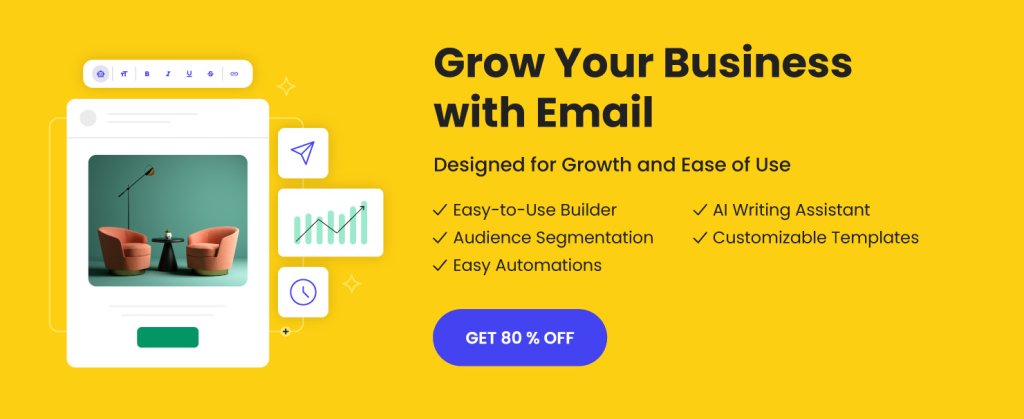

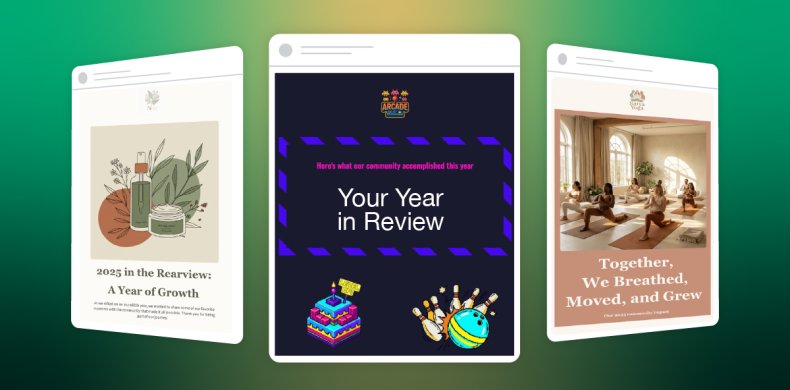
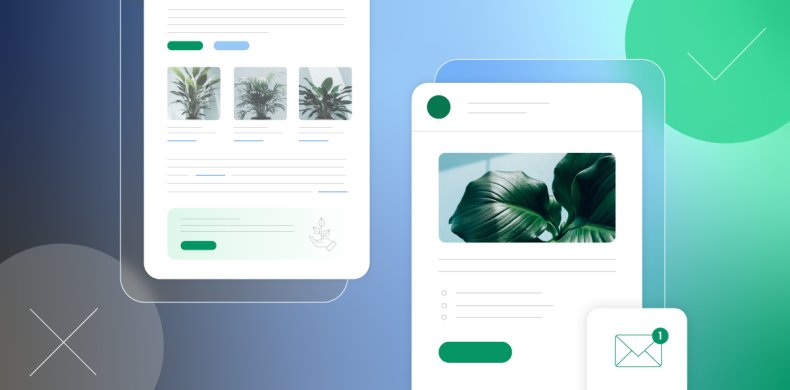
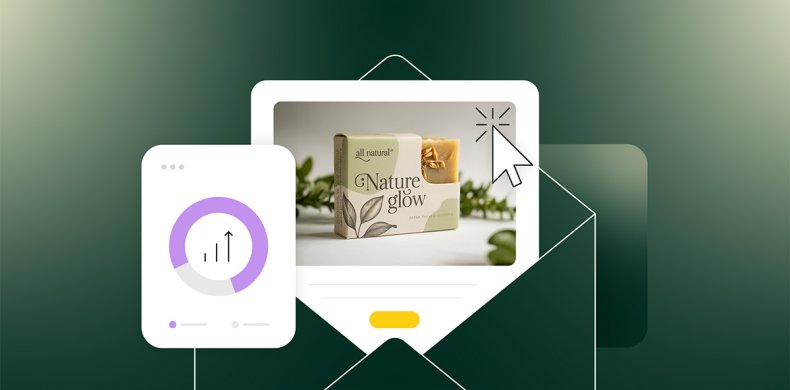
Comments ( 0 )
Thanks! Your comment will be held for moderation and will be shortly published, if it is related to this blog article. Comments for support inquiries or issues will not be published, if you have such please report it through our official channels of communication.
Leave a comment
Thanks! Your comment will be held for moderation and will be shortly published, if it is related to this blog article. Comments for support inquiries or issues will not be published, if you have such please report it through our official channels of communication.